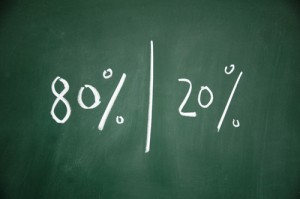How Leads Are Qualified
 The 80-20 rule, also known as Pareto’s Principle, was named after Vilfredo Pareto (1848-1923), an Italian economist who observed that for certain economic conditions, roughly 80% of the effects come from 20% of the causes. For example, during Pareto’s time, he observed that 80% of the land in Italy was owned by 20% of the population, and 80% of the peas in his garden came from 20% of the pea pods.
The 80-20 rule, also known as Pareto’s Principle, was named after Vilfredo Pareto (1848-1923), an Italian economist who observed that for certain economic conditions, roughly 80% of the effects come from 20% of the causes. For example, during Pareto’s time, he observed that 80% of the land in Italy was owned by 20% of the population, and 80% of the peas in his garden came from 20% of the pea pods.
The 80-20 rule has become a widely accepted rule of thumb in business. Many sales organizations have likely noticed that 80% of their sales come from 20% of their sales people. Even in successful, highly competitive organizations, high performers find a way to stand out beyond the crowd.
Today’s sales organizations need to take a new look at the 80-20 rule to see how to drive more value with less expenditure and effort. If 80% of your sales are coming from just 20% of your sales efforts, you need to find a way to maximize your investment of time and resources on the vital 20%, and less time and resources on the less effective 80% of your efforts.
There are a few ways that the 80-20 rule might be appearing in your sales organization:
- 80-20 sales performers: Many sales managers complain about 80-20 performance on their sales teams, where approximately 80 percent of sales are produced by approximately 20 percent of salespeople. The challenge: constantly reward your high performers, train and support your lower performers, and maintain high standards of hiring so that you’re constantly bringing in new blood on the sales team that can perform at a higher level than the people they replaced.
- 80-20 back end: If you look at the back end of your sales process, where sales proposals and closing ratios are tracked, you will often see low closing ratios – for example, 80% of revenues coming from 20% of proposals. The challenge here is, how can we identify which proposals are more likely to be effective?
80-20 performance and 80-20 closing ratios are the “usual suspects” of the 80-20 rule for sales, but from my experience of over 30 years as a former sales rep, B2B sales manager and owner of a lead generation firm, the true impact of the 80-20 rule goes far beyond closing ratios.
80-20 rule for sales: Look at the front end
I have seen this issue from many angles over the past 30 years. What I have learned is that if you want to understand the true impact of the 80-20 rule on your revenues, you have to look not only at closing ratios (the back end of your sales process) but also at the management of the sales lead follow up process (the front end of your sales process).
Why? If you are just looking at closing percentages and calculating how many deals your reps are closing, you are looking at a small sample size: those few proposals that have already made their way deep into your sales process. By this measure you are not capturing all the potential deals that never made it beyond the first or second call and failed to advance to the proposal stage of your sales cycle.
By all means, track the closing ratios of your individual sales reps. This is a good way to figure out who your top closers are, and who needs additional training or support.
But if you want to break out of the 80-20 rule trap, more significant than the proposals not closing is taking a look at the larger number of deals that are not advancing beyond your first sales “touch” at the early sales lead follow-up stage.
It’s here in the front end that the most significant amount of revenue potential is lost as there are typically many more deals failing then advancing. If you can find a way to boost the number of deals that go beyond an initial cold call, you’re likely to increase the number of deals that you close.
Getting past the 80-20 rule is about more than improving your team’s skill in closing deals. You also need to get better at nurturing sales leads along the way, so you can draw from a bigger pool of qualified leads and improve your conversion ratios at every step of the sales process.
Click here to read: Part 2: 80/20 Sales Rule: Implementing a Cure
Strategic Sales & Marketing (SSM) is a B2B lead generation and appointment setting firm that helps companies develop smarter strategies for sales appointment setting, sales lead qualification and lead management. Our team of experienced appointment setters and sales consultants have helped make over 50 million sales calls during the past 22 years.